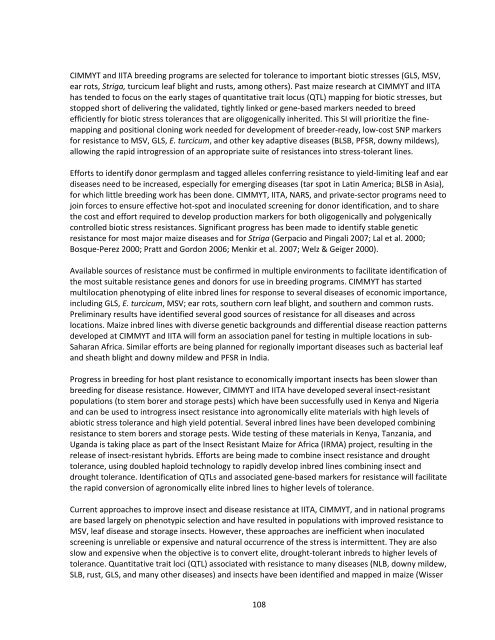Download - Maize
Download - Maize
Download - Maize
Create successful ePaper yourself
Turn your PDF publications into a flip-book with our unique Google optimized e-Paper software.
CIMMYT and IITA breeding programs are selected for tolerance to important biotic stresses (GLS, MSV,<br />
ear rots, Striga, turcicum leaf blight and rusts, among others). Past maize research at CIMMYT and IITA<br />
has tended to focus on the early stages of quantitative trait locus (QTL) mapping for biotic stresses, but<br />
stopped short of delivering the validated, tightly linked or gene‐based markers needed to breed<br />
efficiently for biotic stress tolerances that are oligogenically inherited. This SI will prioritize the finemapping<br />
and positional cloning work needed for development of breeder‐ready, low‐cost SNP markers<br />
for resistance to MSV, GLS, E. turcicum, and other key adaptive diseases (BLSB, PFSR, downy mildews),<br />
allowing the rapid introgression of an appropriate suite of resistances into stress‐tolerant lines.<br />
Efforts to identify donor germplasm and tagged alleles conferring resistance to yield‐limiting leaf and ear<br />
diseases need to be increased, especially for emerging diseases (tar spot in Latin America; BLSB in Asia),<br />
for which little breeding work has been done. CIMMYT, IITA, NARS, and private‐sector programs need to<br />
join forces to ensure effective hot‐spot and inoculated screening for donor identification, and to share<br />
the cost and effort required to develop production markers for both oligogenically and polygenically<br />
controlled biotic stress resistances. Significant progress has been made to identify stable genetic<br />
resistance for most major maize diseases and for Striga (Gerpacio and Pingali 2007; Lal et al. 2000;<br />
Bosque‐Perez 2000; Pratt and Gordon 2006; Menkir et al. 2007; Welz & Geiger 2000).<br />
Available sources of resistance must be confirmed in multiple environments to facilitate identification of<br />
the most suitable resistance genes and donors for use in breeding programs. CIMMYT has started<br />
multilocation phenotyping of elite inbred lines for response to several diseases of economic importance,<br />
including GLS, E. turcicum, MSV; ear rots, southern corn leaf blight, and southern and common rusts.<br />
Preliminary results have identified several good sources of resistance for all diseases and across<br />
locations. <strong>Maize</strong> inbred lines with diverse genetic backgrounds and differential disease reaction patterns<br />
developed at CIMMYT and IITA will form an association panel for testing in multiple locations in sub‐<br />
Saharan Africa. Similar efforts are being planned for regionally important diseases such as bacterial leaf<br />
and sheath blight and downy mildew and PFSR in India.<br />
Progress in breeding for host plant resistance to economically important insects has been slower than<br />
breeding for disease resistance. However, CIMMYT and IITA have developed several insect‐resistant<br />
populations (to stem borer and storage pests) which have been successfully used in Kenya and Nigeria<br />
and can be used to introgress insect resistance into agronomically elite materials with high levels of<br />
abiotic stress tolerance and high yield potential. Several inbred lines have been developed combining<br />
resistance to stem borers and storage pests. Wide testing of these materials in Kenya, Tanzania, and<br />
Uganda is taking place as part of the Insect Resistant <strong>Maize</strong> for Africa (IRMA) project, resulting in the<br />
release of insect‐resistant hybrids. Efforts are being made to combine insect resistance and drought<br />
tolerance, using doubled haploid technology to rapidly develop inbred lines combining insect and<br />
drought tolerance. Identification of QTLs and associated gene‐based markers for resistance will facilitate<br />
the rapid conversion of agronomically elite inbred lines to higher levels of tolerance.<br />
Current approaches to improve insect and disease resistance at IITA, CIMMYT, and in national programs<br />
are based largely on phenotypic selection and have resulted in populations with improved resistance to<br />
MSV, leaf disease and storage insects. However, these approaches are inefficient when inoculated<br />
screening is unreliable or expensive and natural occurrence of the stress is intermittent. They are also<br />
slow and expensive when the objective is to convert elite, drought‐tolerant inbreds to higher levels of<br />
tolerance. Quantitative trait loci (QTL) associated with resistance to many diseases (NLB, downy mildew,<br />
SLB, rust, GLS, and many other diseases) and insects have been identified and mapped in maize (Wisser<br />
108

















